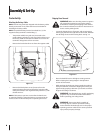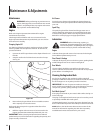
Throttle / Choke Control
The throttle control lever is located on the right side of the
tractor’s dash panel, see Fig. 4-1. This lever controls the speed
of the engine, as well as the choke when it is pushed all the way
forward. When set in a given position, the throttle will maintain a
uniform engine speed.
IMPORTANT: When operating the tractor with the cutting deck
engaged, be certain that the throttle lever is always in the FAST
(rabbit) position.
Moving the throttle lever all the way forward activates the
engine’s choke control. See Figure 4-2. Activating the choke
control closes the choke plate on the carburetor and aids in
starting the engine.
Refer to Starting The Engine in the Operation section of this
manual for detailed starting instructions.
Ignition Switch
The ignition switch is activated to start the engine. Insert key
into the ignition switch and turn clockwise to the START position.
Release the key into the ON position once engine has fired. See
Fig. 4-3.
WARNING! Never leave a running machine
unattended. Always disengage PTO, move shift lever
into neutral position, set parking brake, stop engine
and remove key to prevent unintended starting.
IMPORTANT: Prior to operating the tractor, refer to both Safety
Interlock Switches and Starting The Engine in the Operation section
of this manual for detailed instructions regarding the Ignition Switch
Module.
Clutch-Brake Pedal
The clutch-brake pedal is located on the left side of the lawn
tractor, along the running board. Depress the clutch-brake pedal
part way down when slowing the tractor by changing speeds
(Refer to Speed Control Lever). Depress the pedal all the way down
to engage the disc brake and bring the tractor to a complete stop.
NOTE: The clutch-brake pedal must be depressed to start the
engine. Refer to Safety Interlock Switches in the Operation
section of this manual.
Shift Lever
The shift lever is located on the left side of the fender and has
three positions, FORWARD, NEUTRAL and REVERSE. The brake
pedal must be depressed and the tractor must not be in motion
when moving the shift lever. See Figure 4-4.
IMPORTANT: Never force the shift lever. Doing so may result in
serious damage to the tractor’s transmission.
Figure 4-2
On/Lights
Start
Figure 4-3
Figure 4-4
11sectiOn 4 — cOntrOls & features


















